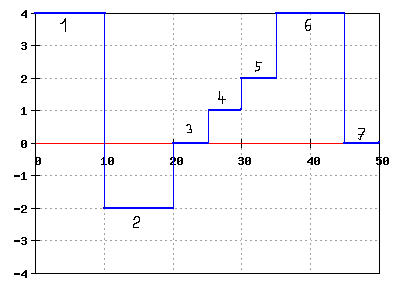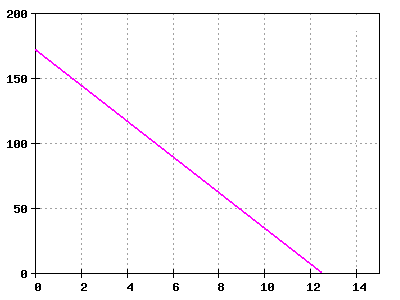Secondary Mechanics/Page4: Linear Motions
Exercise 1.7
Helen is showjumping and her coach records her movement data with a laser gauge. The data are shown on a screen, a little idealized, as t-v-diagram and as t-x-diagram. The diagrams assist coach and rider to analyze the single phases of the process.
First Helen is moving towards the hindrance with constant speed (1) until the horse suddenly balks and regresses (2). Helen stops it (3) to try once angain and increases the speed.
At 40 s the jump takes place (6), after the landing the horse stops again (7).
Exercise 1.7 Jump Hurdles
Verbesserungsvorschlag
Helena and her horse make a jump over a Hurdle and her teacher takes the dynamic dates with a laser measuring device. The dates get demonstrated on a computer screen in form of a time-velocity and a time-position-diagram. The diagrams help them to analyse the individual phases of the process. First Helen on her horse is moving with constant speed towards the hurdle(1) till the horse suddenly shy’ s and walks back .Helen stops her horse ,try’s again and increases the speed. After 40 seconds the horse jumps and as the horse lands it stops again.
[math]\Delta x[/math] = v[math]\Delta t[/math]
t in s..............4,2.....7,5......9,0.......12,7........14,0
x in m...........12,0....74,1...93,6.....152,4......178,6
Exercise 1.11: Flashed
Group A:
The movement of a car is recorded by a radar device, working with ultrasonic waves. The first impulse is sent at t1 = 0.65 sec, the wave is reflected by the car and it comes back at the radar by t2 = 0.95 sec. The place where the radar device set is at x = 0. A second impulse is sent at t3 = 3.80 sec, this impulse comes back at t4 = 4.80 sec. The speed of the car 'v' is constant.
a) Draw a qualitative t-x diagram of this procedure!(No nummbers) Don´t forget to draw the time-place-lines of the ultrasonic waves as well as the car.
b) Calculate the speed of the car 'v' in km/h if the speed of the ultrasonic waves vs is 340 m/s.
c) Now try to calculate or draw the position of the car for the time t = 0.
Group B:
The movement of a car is seized by a radar device, which works with ultrasonic. In addition at the time T1 = a sound impulse is sent to 1.80 s, which arrives after reflection at the car at time t2 = 2.80 s again at the equipment. This is at the place x = 0. A second impulse is sent at present T3 = to 4.65 s and returns at present t4 = 4.95 s. The speed of v of the car remains thereby the whole time constantly.
--Kenny 12:15, 16 November 2007 (CET), --Marc 12:16, 16 November 2007 (CET)

